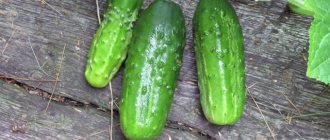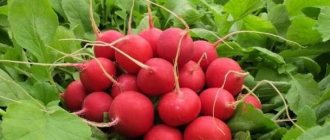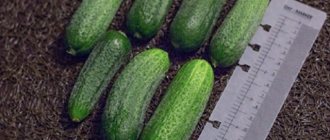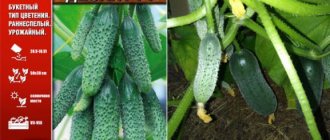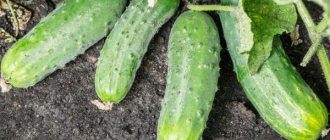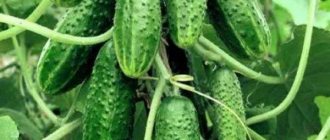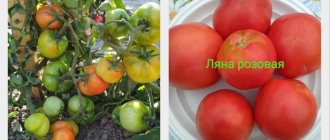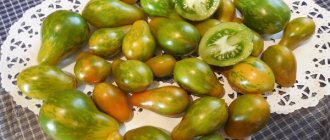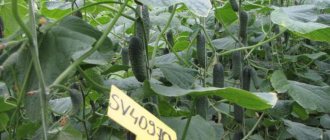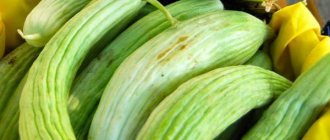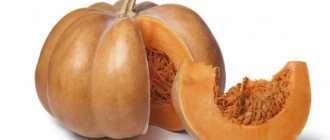Cucumber Friendly Family F1 is an ideal hybrid for canning and pickling. When prepared, its taste becomes unsurpassed, and cucumbers can be collected for preservation at any stage of ripeness. In addition, it will appeal to those who like to crunch fresh vegetables.
| Landing location | Ripening time | Mode of application | Fruit length | Group | Fruit smoothness | Pollination method |
| Universal | Early ripening (35-45 days) | Universal | Medium - from 10 to 15 cm | Hybrid | Highly lumpy | Parthenocarpic |
Description and characteristics of the variety
Hybrid Friendly Family F1 was created by breeders from. Since 2003, it has been included in the State Register of the Russian Federation. It is recommended to grow it in greenhouses and shelters, although in open ground, according to reviews from gardeners, the cultivar grows no worse.
The variety has medium-sized indeterminate bushes. Medium branching. The flowers are mostly female and do not require pollination by bees. The ovaries grow in bunches of 3-4 on the central shoot and 6-7 on the side shoots. The originator states that the hybrid has ultra-early ripening periods.
The fruit can reach a length of 10-12 cm. However, the fruits are often collected at the gherkin stage (up to 10 cm), when they are still crisp, pickles (4 cm each) for preparations. The ripe fruit reaches 3 cm in diameter. It has a bright green skin with barely noticeable whitish stripes and large tubercles. White spines are present. The pulp is tasty, juicy, no bitterness is felt.
The fruits of this hybrid tend to outgrow if they are not collected in time, so the harvest must be harvested regularly.
Advantages and disadvantages
Cucumber seeds Friendly Family F1 are quite expensive, since they were obtained as a result of breeding work. It will not be possible to collect your own seed material, because... parthenocarpics do not form seeds, and fertilization does not occur. Even if bees can pollinate some female flowers, the seeds will not produce offspring with varietal properties, like all hybrids. This is one of the few disadvantages of the variety for the consumer.
Advantages of the Friendly Family cucumber variety:
- high yield - 10 kg per sq.m (according to some sources, it can reach 17-20 kg);
- good and excellent taste;
- versatility in use: suitable for fresh consumption, as well as for pickles and pickling;
- resistance to many diseases of the pumpkin family.
It must be remembered that during pollination of parthenocarpics, if seeds are formed, the greens may become deformed and bitterness may appear.
Landing
It is better to grow a hybrid through seedlings, but in the southern regions the seeds can be sown directly in open ground or in a greenhouse. If the greenhouse is heated, then you can start planting seeds for seedlings in February. For unheated shelters, seedlings are sown in April or even May. In general, the main requirement is one: at the time of sowing or transferring the bushes to a permanent place, the soil temperature should not be lower than +15 degrees.
When preparing the site, it is necessary to ensure the following conditions:
- sunny place, preferably on a hill and without drafts;
- nutritious, well-manured and loosened soil;
- the optimal type of soil is sandy loam;
- normal acidity (if necessary, add dolomite flour or chalk to reduce the indicator).
You should not plant cucumbers where pumpkin or melon crops grew before them.
For seedlings, prepare a nutrient substrate and small containers of 300-500 ml, preferably peat. 1-2 seeds are planted in each and germinated at high temperature. When the sprouts appear, the average daily temperature is set at +20, and the pots are transferred to a lighted place.
When the bushes have 4-5 leaves, you can transfer them to the garden bed.
Plants are placed at a distance of 30-50 cm from each other and wide row spacing of 1-1.2 m is made so that supports can fit there and the bushes have enough air.
When planting seeds directly into the ground, the same scheme and method are followed, but the soil after sowing is mulched to ensure better germination.
Features of cultivation
Landing
Growing in a greenhouse will bring a good harvest
This hybrid has no special requirements for agricultural technology. General requirements for disembarkation:
- loose, well-manured soil;
- recommended predecessors - tomatoes, cabbage;
- temperature not lower than 15°C.
Cucumbers are usually planted in a greenhouse using seedlings. Planting time depends on the type of greenhouse and the conditions created in it. In a heated plant you can start growing in February, with solar heating - in April - early May (depending on the temperature). Young plants should produce 4-5 true leaves.
Scheme for planting cucumber seedlings: the distance between holes in a row is 30-50 cm (depending on the characteristics of the plant), between rows is 120 cm. The depth of seeding is 2 cm. Before planting, moisturizing watering is carried out and the soil is aerated.
Gardeners who grew cucumbers in greenhouses on warm beds obtained excellent results.
Care
Water the cucumbers with warm water (25°C) at the root 2-3 times a week (drip watering is an excellent option). Do not allow the soil to dry out and water to stagnate. After watering, loosening is carried out and weeds are destroyed. It is combined with fertilizing with organic and inorganic fertilizers.
To obtain high yields, tying and pinching are carried out in a timely manner. The wire for tying the bushes is pulled at a height of 1.8-2 m. Twine is tied to it, and the plants under 2-3 leaves are secured with a free loop, preventing them from being crushed.
After reaching the 8-9 leaf phase, they begin to form a bush. New shoots are pinched off at the lower internodes. The side pagons located above are pinched at the level of 2-3 leaves. The central stem is pinched after it has grown to the trellis wire and is fixed there.
Timely collection of greens stimulates the formation and development of ovaries.
Growing and care
Bushes need abundant watering. In this case, the stems should not be wetted. The water should be warm, watering should be done once every 3-4 days, and in hot weather - daily. The optimal time for the procedure is morning.
As the crust appears on the surface of the soil, it is loosened, carefully breaking it with a glander. Near the plants, the crust is pierced with a pitchfork.
During the season, the bushes need several feedings. It is better to alternate organic matter with mineral fertilizers.
Applying too large portions of fertilizer at a time is contraindicated. It is better to add them little by little, but at shorter intervals.
From organic matter, a solution of bird droppings 1:20 or mullein 1:10 is useful. Among complex fertilizers, the effectiveness of Kemira Lux, nitrophoska, superphosphate, and Mortar is noted.
Cheerful cucumber in your beds characteristics of the hybrid
Agree, the original names of cucumbers always attract attention, and if they also delight you with a good harvest, then such vegetables have no price. The mid-early parthenocarpic Friendly Family F1 was bred by breeders of famous agro, recommended for growing both in beds and under shelters
The plant is powerful, medium-branched, and its growth type is classified as an indeterminate hybrid. On a strong stem, many side shoots are formed, medium-sized leaves, rich green in color.
In the axils of the main stem there can be up to 3-4 ovaries, on the lateral branches there are more, up to 6-7 ovaries. A hybrid of predominantly female flowering type, does not require pollination by insects. Feels great in open ridges, produces high yields in greenhouses of any type (film, polycarbonate).
ON A NOTE! In the description of the Friendly Family F1, it is especially noted that in order to obtain a high yield, enhanced feeding of the hybrid is recommended.
The greens are cylindrical in shape, beautiful, aligned. They have dense, tuberous skin, green color with longitudinal whitish stripes. They grow up to 10 cm in length, have white spines and frequent pubescence (see photo).
The pulp has a pleasant taste, juicy, without bitterness. These cucumbers are good fresh, but their flavor is most fully revealed in marinades. Those who have already grown this hybrid note in their reviews that gherkins (fruits 3-5 cm) turn out to be especially tasty when preserved.
IMPORTANT! Greens of the Friendly Family can outgrow, so it is necessary to regularly harvest during the period of mass yield of fruits. If you follow all the rules of agricultural technology, you can collect up to 10-11 kg of delicious greens from one square meter
If you follow all the rules of agricultural technology, you can collect up to 10-11 kg of delicious greens from one square meter.
Care
Cucumbers The Real Colonel
The beds should be watered 3 times a week with warm water (25 degrees), watered at the roots, otherwise the stem and leaves can be damaged. It is advisable to water not with plain water, but with organic fertilizers, so the harvest will be of better quality. The proportions for diluting fertilizers are indicated on the packaging; usually a couple of teaspoons per 10-15 liter bucket of water is enough.
Proper care
Important! If the plants do not receive enough moisture, the fruits will grow bitter. If you can them, the bitterness will go away, but fresh they will be tasteless.
To get a high yield, you need to do tying and pinching. To do this, you need to stretch the wire to a height of 2 meters and fix the plant under 2-4 leaves. You need to tie it carefully so as not to crush the delicate stems. Although there is an opinion that for parthenocarpic varieties there is no need for garter.
Characteristics and description of cucumbers
Parthenocarpic (does not require pollination by bees) Friendly Family cucumber is intended for cultivation in open and protected ground conditions.
The variety is characterized by an average early ripening period; it takes 43-48 days from the moment of emergence to the first harvest. The description of the plant is associated with the characteristics of the indeterminate type of bush.
The cucumbers are cylindrical in shape, with a surface with an average number of tubercles. The length of the cucumbers is 10-12 cm, the diameter of the fruit is 2.5-3 cm, the weight is 80-100 g. The skin of the cucumbers is green, with blurry white stripes on the surface.
The characteristics of the taste of gherkins are associated with the description of the pulp of a dense consistency, in which there is no bitterness. The variety is characterized by high and stable yields and a long fruiting period. The fruits can be removed from the plant at the stage of formation of pickles (fruit length 3-5 cm).
In cooking, the variety has a salad purpose, but the fruits are best suited for pickling and pickling. The fruits are used for cosmetic purposes as a cucumber mask.
The description of the Cheerful Family cucumber fully corresponds to the Friendly Family hybrid, so we can assume that similar names correspond to the same type of seeds. The Cheerful Family variety is easy to care for and is grown indoors. The plant is characterized by productivity, bunch formation of ovaries.
The value of the hybrid lies in its resistance to disease, stable yield at the level of 17-20 kg per 1 m².
It has already been noted that this hybrid is unpretentious, but certain rules for its cultivation must be followed.
Choosing a bed
Cucumber is a lover of sun and warmth, so the garden bed should be well lit and protected from the winds. High yields are obtained on loose, nutritious soils, which are prepared in the fall. Sandy loam and organic-rich soil will be an ideal place for growing a hybrid.
IMPORTANT! Acidic soils are improved using ash, chalk or dolomite flour.
In the fall, fertilizers are applied: manure, compost, superphosphate.
Description of the variety “Friendly Family F1”
Cucumber under the creative name “Friendly Family” is supplied to Russian vegetable growers by several agribusinesses, “Sedek”, “Uralsky Dachanik”. The varietal characteristics of the hybrid, regardless of the originator company, are similar. It belongs to the parthenocarpic, early-ripening bunch-type varieties. Suitable for cultivation on farms and for amateurs in small garden plots.
The “Friendly Family” bush belongs to the indeterminate type of growth. The length of the whip reaches 2-2.5 meters. The branching of the vine is weak, there are few lateral stepsons. The color of the stems is light green. The surface of the lashes and leaves is covered with prickly pubescence. The root system is powerful, fibrous. The hybrid begins to bear fruit on the 37-39th day from germination. No pollination required. Most of the harvest is given in the first month. But due to fertilizing, it can bear fruit for up to 3 months. It tolerates temperature fluctuations, cold snaps at night and other stresses.
The fruits of the “Friendly Family f1” are very similar in appearance to the cucumbers of the “Merry Family f1”. The average length of vegetables is 7-9 cm. The color of the skin is dark green. The entire surface is covered with tubercles and small white spines. The taste is high. The elastic and juicy pulp does not taste bitter and retains turgor during pickling and other preservation. Small green vegetables are pleasant to serve even without cutting, whole.
Miniature vegetables can be stored even in small jars for pickling. The hybrid “Friendly Family f1” often becomes the choice of vegetable growers for its good immunity to diseases and pests. It is unpretentious and therefore suitable for industrial cultivation.
Not all gardeners like the friendly return of a larger volume of harvest in the first month. Therefore, this property is often considered a disadvantage. Other vegetable growers, on the contrary, value the sprinting qualities of vegetables.
For information!
To shorten the ripening time of vegetables and increase the volume of the harvest, it is recommended to pinch the growth point of the side vines. It is enough to leave 5-6 leaves on each shoot. Pinching a shoot means breaking its crown to prevent further growth. The plant will not waste energy on the growth of greenery, but will direct it to the formation of fruits.
How to grow?
The variety is grown in seedlings in greenhouses or in open ground under a film. This is a strong culture that is not afraid of cold weather, pests, or diseases. Gives an excellent harvest in any conditions.
They grow seedlings at home on the windowsill in special containers. Plant seeds in March or April.
If we talk about the characteristics of cultivation, it should be noted that this plant has its own requirements. If you follow them, you can improve the quality of the crop.
Before sowing seeds, they should be treated against fungus and infections. Earthlings must be too sour. After the first leaves peck, make a pick.
They are planted in the soil only when it warms up to 18 degrees. First, the soil is loosened, fertilized and watered. It is better to prepare the land in the fall. Plants should be planted, keeping a distance so that it is convenient to approach them, so that they do not interfere with each other’s development. The distance between the bushes should be about thirty centimeters. If grown correctly, the cheerful company of a friendly family will delight you with a bountiful harvest in greenhouses.
See also
Description of the cucumber variety Siberian Express, features of cultivation and careRead
